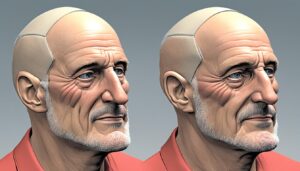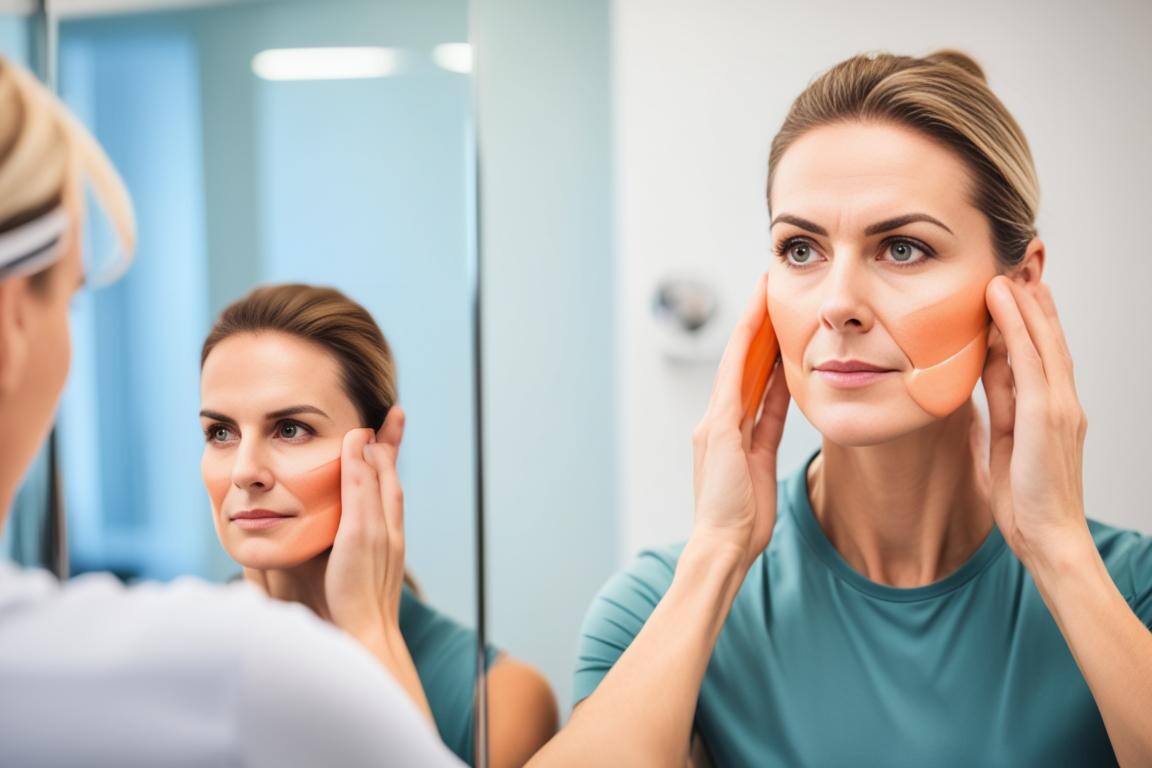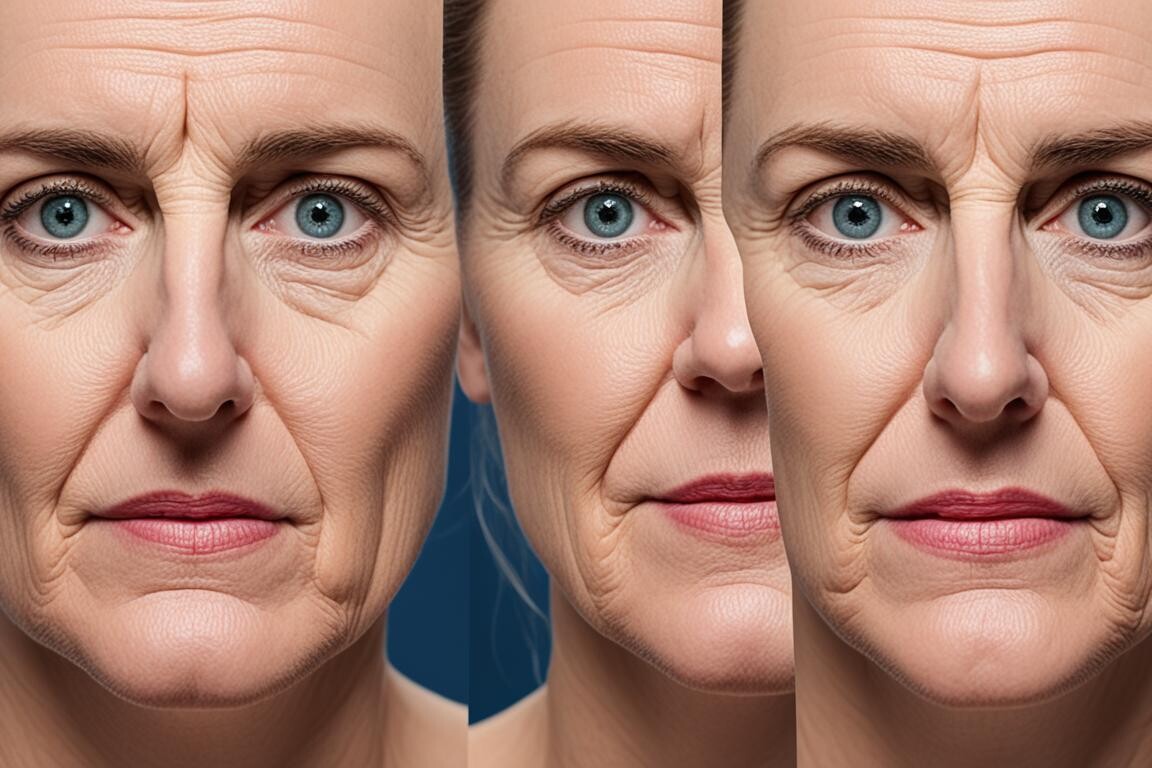Bell’s palsy, a temporary form of facial paralysis, can be debilitating and significantly impact your daily life. Physical therapy is a crucial component of Bell’s palsy treatment, helping to improve facial strength and promote recovery. If you experience facial weakness, seeking medical care immediately is important as it can also indicate more severe conditions like a stroke. Physical therapists, who are movement experts, can provide hands-on care, educate you about your condition, and prescribe specific exercises to regain facial strength and function.
Key Takeaways:
- Bell’s palsy is a temporary form of facial paralysis that requires treatment.
- Physical therapy plays a crucial role in improving facial strength and promoting recovery.
- Seek immediate medical care for facial weakness to rule out more severe conditions.
- Physical therapists are movement experts who can provide hands-on care and prescribe exercises.
- Work closely with a licensed physical therapist for personalized treatment and optimal results.
Table of Contents
ToggleWhat Is Bell’s Palsy? Understanding the Condition
Bell’s palsy is a sudden and temporary form of facial paralysis that occurs when the facial nerve becomes inflamed or damaged. It is characterized by the weakness or paralysis of the muscles on one side of the face.
The exact cause of Bell’s palsy is often unclear, but it is thought to be related to viral infections, particularly the herpes simplex virus (HSV). This inflammation of the facial nerve can result in various symptoms such as facial asymmetry, difficulty closing the eye, drooping of the mouth, and loss of taste.
While the exact mechanism behind the development of Bell’s palsy is not fully understood, it is believed that the herpes simplex virus causes an inflammatory response in the facial nerve, leading to the onset of facial paralysis.
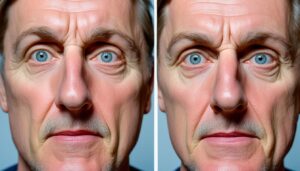
In most cases, Bell’s palsy improves naturally within six months, as the inflammation subsides and the facial nerve begins to heal. However, some individuals may experience long-term effects or may not fully recover their pre-palsy facial functionality.
Understanding the causes and symptoms of Bell’s palsy is essential for timely diagnosis and appropriate treatment. The next section will explore the signs and symptoms of Bell’s palsy in more detail.
Signs and Symptoms of Bell’s Palsy
Bell’s palsy is characterized by a range of noticeable bell’s palsy symptoms that can significantly affect facial function and appearance. Recognizing these signs is crucial in seeking prompt medical attention and initiating appropriate treatment. The following are the common symptoms associated with Bell’s palsy:
Facial Weakness and Paralysis
The most prominent symptom of Bell’s palsy is the sudden onset of facial weakness or paralysis on one side of the face. This weakness can lead to difficulties in performing simple tasks such as smiling, blinking, and closing the affected eye. The severity of the weakness may vary from mild to complete facial paralysis.
Drooping of the Mouth and Eyelid
In addition to facial weakness, Bell’s palsy often causes drooping of the mouth or eyelid on the affected side. This drooping may create an asymmetrical appearance and affect speech and eating patterns, impacting daily life activities.
Loss of Taste
Another common symptom of Bell’s palsy is the loss of taste on the front two-thirds of the tongue. This can significantly affect a person’s enjoyment of food and beverages. The sense of taste is closely linked to the sense of smell, so some individuals with Bell’s palsy may also experience changes in their ability to detect and identify different smells.
Increased Sensitivity to Sound
Bell’s palsy can also cause increased sensitivity to sound in one ear. Individuals may notice that certain sounds or noises are louder or more bothersome in the ear on the affected side.
Eye Closure and Corneal Protection
Due to facial weakness, individuals with Bell’s palsy may experience difficulty fully closing the eye on the affected side. This can lead to eye dryness, irritation, and potentially damage to the cornea. It is essential to take appropriate measures, such as using eye drops and wearing protective eyewear, to prevent complications and ensure proper eye care.
Recognizing these signs and symptoms is crucial in differentiating Bell’s palsy from other conditions that may cause similar facial weakness. If you experience any of these symptoms, it is recommended to seek medical attention promptly for a proper diagnosis and appropriate treatment.
| Symptoms | Description |
|---|---|
| Facial Weakness and Paralysis | Sudden weakness or paralysis on one side of the face, leading to difficulties in smiling, blinking, and closing the eye. |
| Drooping of the Mouth and Eyelid | Drooping of the mouth or eyelid on the affected side, causing asymmetry and impacting speech and eating patterns. |
| Loss of Taste | Loss of taste on the front two-thirds of the tongue, affecting the enjoyment of food and beverages. |
| Increased Sensitivity to Sound | Heightened sensitivity to sound in one ear, with certain noises or sounds appearing louder or more bothersome. |
| Eye Closure and Corneal Protection | Difficulty in fully closing the eye on the affected side, leading to dryness, irritation, and potential corneal damage. |
What Causes Bell’s Palsy?
Bell’s palsy is a condition characterized by the sudden paralysis or weakness of facial muscles on one side of the face. While the exact cause is not fully understood, it is believed to be associated with several factors, including viral infections, inflammation of the facial nerve, and the immune system’s response. Let’s take a closer look at these potential Bell’s Palsy causes:
Viral Infections:
One of the main causes of Bell’s palsy is viral infections, particularly the herpes simplex virus (HSV). These viral infections can lead to inflammation and swelling of the facial nerve, resulting in the characteristic facial paralysis.
Facial Nerve Inflammation:
Bell’s palsy is often attributed to the inflammation or compression of the facial nerve, which controls the muscles responsible for facial expressions. This inflammation disrupts the normal functioning of the nerve, leading to the development of Bell’s palsy.
Immune System Response:
The immune system plays a crucial role in the development of Bell’s palsy. It is believed that an abnormal immune system response to viral infections or other stimuli can trigger inflammation and damage to the facial nerve, resulting in the onset of Bell’s palsy symptoms.
Other Factors:
In addition to viral infections, facial nerve inflammation, and immune system response, other factors can contribute to the development of Bell’s palsy. These include hereditary factors, environmental factors such as exposure to cold weather or wind, as well as autoimmune reactions.
While viral infections, especially the herpes simplex virus, are commonly associated with Bell’s palsy, it’s important to note that multiple factors may contribute to its development. Further research is needed to fully understand the complex causes of Bell’s palsy.

Diagnosis of Bell’s Palsy
The diagnosis of Bell’s palsy is essential to determine the appropriate treatment and rule out other potential causes of facial paralysis. To diagnose Bell’s palsy, a medical professional will conduct a thorough assessment that involves gathering a detailed medical history and performing a physical examination.
During the medical history interview, the doctor will ask about the onset and progression of symptoms, recent illnesses, exposure to viruses, and any other relevant factors. This information helps in identifying patterns and potential triggers that may be associated with Bell’s palsy.
Following the medical history, a physical examination is conducted to evaluate facial muscle strength, symmetry, and the ability to perform various facial expressions. The doctor will assess the degree of weakness or paralysis on one side of the face and observe any changes in muscle tone and facial symmetry.
In some cases, additional tests may be ordered to rule out other causes of facial paralysis. These tests may include blood tests, imaging studies such as MRI or CT scans, and nerve conduction studies. These tests help in excluding conditions like stroke, tumors, trauma, and neurological disorders that may also present with facial paralysis.
Once other potential causes are ruled out, and a thorough assessment is completed, the medical professional can confidently diagnose Bell’s palsy.
| Diagnosis Process | Key Steps |
|---|---|
| Medical History | – Gathering information about symptoms, illnesses, and exposure to viruses. – Establishing the timeline and progression of symptoms. – Identifying potential triggers. |
| Physical Examination | – Assessing facial muscle strength, symmetry, and mobility. – Evaluating the ability to perform various facial expressions. – Observing changes in muscle tone and facial symmetry. |
| Additional Tests | – Conducting blood tests to rule out other conditions. – Ordering imaging studies (MRI or CT scans) to assess the facial nerve and exclude structural abnormalities. – Nerve conduction studies to evaluate nerve function. |
Through a comprehensive evaluation process, a medical professional can make an accurate diagnosis of Bell’s palsy, enabling timely and appropriate treatment to be initiated.
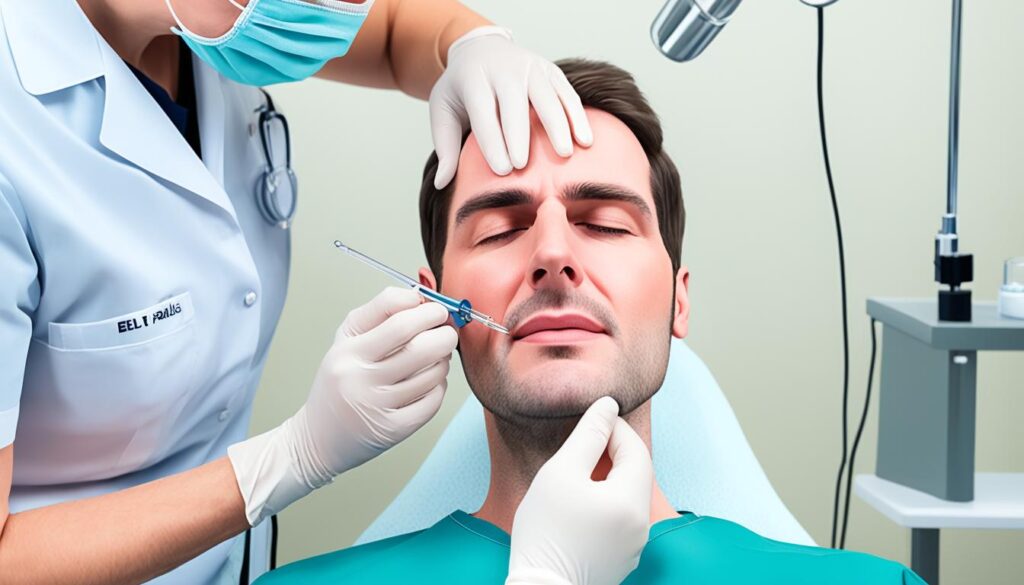
How Bell’s Palsy Can Be Treated With Physical Therapy
Physical therapy plays a crucial role in the treatment of Bell’s palsy. It helps manage and improve muscle weakness and facial asymmetry caused by the condition. With the guidance of a licensed and experienced physical therapist, a personalized treatment plan can be designed to address the specific needs of each individual.
Facial muscle strengthening exercises and facial exercises are key components of physical therapy for Bell’s palsy. These exercises focus on improving muscle strength, coordination, and range of motion in the affected areas of the face. By regularly performing these exercises, the facial muscles can regain their strength and help restore facial symmetry.
In addition to muscle strengthening exercises, biofeedback techniques can be used to enhance muscle activation and coordination. Biofeedback provides real-time information on muscle activity, allowing individuals to learn how to control their facial muscles more effectively.
Furthermore, eye protection and care are important aspects of physical therapy for Bell’s palsy. The inability to fully close the eye on the affected side can lead to eye damage and dryness. Protecting the eye with eye drops, ointments, or a patch can help prevent complications and promote healing.
Physical therapy for Bell’s palsy should always be carried out under the guidance of a licensed physical therapist. They will assess the individual’s condition and prescribe the appropriate exercises and techniques tailored to their needs. Regular sessions with the physical therapist, coupled with consistent at-home exercises, can significantly improve facial strength, function, and overall quality of life for individuals with Bell’s palsy.
Physical Therapy Exercises for Bell’s Palsy
Physical therapy exercises can be highly effective in improving facial muscle strength, coordination, and movement on the affected side of the face for individuals with Bell’s palsy. These exercises, when performed under the guidance of a physical therapist, can help facilitate a faster and more comprehensive recovery. Consistency and gradual progression are key to achieving optimal results.
Eye Blinking Exercise
Bell’s palsy exercises often include eye blinking exercises to strengthen the muscles involved in blinking and protect the eye from dryness and potential damage. Here’s a simple eye blinking exercise you can try:
- Close your unaffected eye.
- Blink your affected eye gently and progressively increase the speed and intensity of the blinking.
- Repeat this exercise for a few minutes, taking short breaks if needed.
Smile Exercise
Smile exercises can help improve facial symmetry and strengthen the muscles responsible for smiling.
- Relax your facial muscles.
- Attempt to smile as wide as possible, lifting the corners of your mouth towards your ears.
- Hold the smile for a few seconds, then relax your facial muscles.
- Repeat this exercise several times, gradually increasing the duration of each smile.
Eye Closure Resistance Exercise
Eye closure resistance exercises aim to strengthen the muscles involved in fully closing the affected eye. This exercise can help prevent eye dryness and protect the eye from potential damage. Here’s how to perform it:
- Sit upright and relax your facial muscles.
- Use your fingers to gently apply resistance against your affected eyelid while attempting to close it fully.
- Hold the resistance for a few seconds, then relax your facial muscles.
- Repeat this exercise for several repetitions, gradually increasing the intensity of the resistance.
Eyebrow Raise Exercise
The eyebrow raise exercise targets the muscles responsible for raising the eyebrows, helping to improve facial symmetry and expression.
- Relax your facial muscles.
- Attempt to raise your affected eyebrow as high as possible.
- Hold the raised position for a few seconds, then relax your facial muscles.
- Repeat this exercise multiple times, gradually increasing the duration of each eyebrow raise.
Cheek Puff Exercise
The cheek puff exercise targets the muscles used for puffing the cheeks, aiding in facial muscle coordination and symmetry.
- Relax your facial muscles.
- Puff out your affected cheek as much as possible, feeling the tension in the muscles.
- Hold the puff for a few seconds, then relax your facial muscles.
- Repeat this exercise for several repetitions, gradually increasing the duration of each cheek puff.
Tongue and Lip Mobility Exercise
Tongue and lip mobility exercises can improve facial muscle coordination and control. Here’s one exercise you can try:
- Relax your facial muscles.
- Move your tongue from one side of your mouth to the other, touching the inside of each cheek.
- Purse your lips and move them from side to side, feeling the stretching and contraction of the muscles.
- Repeat this exercise for several repetitions, gradually increasing the speed and range of motion.
Remember, it is essential to perform these exercises gently and consistently under the guidance of a physical therapist. Over time, as the facial muscles regain strength and coordination, you can gradually increase the repetitions and intensity of the exercises. Stay dedicated and patient, as consistent practice can significantly contribute to your Bell’s palsy recovery.

After Bell’s Palsy Recovery
After recovering from Bell’s palsy, you may experience various emotions and adjustments. While many individuals achieve near-complete recovery, some may still have residual effects or slight facial differences. It’s important to remember that the recovery process for Bell’s palsy can take time, and your facial muscles may continue to improve and adapt for several months.
The residual effects of Bell’s palsy, such as mild weakness, muscle stiffness, or subtle facial asymmetry, are typically minimal and may not be noticeable to others. It’s essential to practice patience and understanding during this recovery phase. Allow your body the time it needs to heal and adapt fully.
Engaging in activities that promote relaxation and stress reduction can support your recovery process. Consider incorporating techniques such as deep breathing exercises, meditation, and gentle facial massages into your daily routine. These practices can help relax your facial muscles, alleviate tension, and promote overall well-being.
Remember, everyone’s recovery from Bell’s palsy is unique, so be kind to yourself and celebrate each small improvement along the way. With time and patience, you can regain your facial strength and confidently embrace your renewed appearance.
Ways to Support Your Bell’s Palsy Recovery:
- Practice patience and give yourself time for a complete recovery.
- Engage in stress-reducing activities such as deep breathing exercises and meditation.
- Incorporate gentle facial massages to relax and promote circulation in your facial muscles.
- Celebrate each small improvement in your facial strength and mobility.
Personalized Care and Support:
If you have any concerns or questions during your recovery journey, don’t hesitate to consult with your healthcare provider or physical therapist. They can offer guidance, answer your queries, and provide further assistance specific to your unique situation.
Support from loved ones can also play a crucial role in your recovery. Openly communicate your needs and feelings to those around you, helping them understand and provide the support you require. Remember, you are not alone in your journey towards regaining complete facial strength and function.
| Key Aspects of Bell’s Palsy Recovery | How It Impacts Recovery |
|---|---|
| Residual Effects | Minimal and may include mild weakness, muscle stiffness, or subtle facial asymmetry |
| Facial Differences | Varies among individuals and may not be noticeable to others |
| Time and Patience | Recovery can take several months as facial muscles continue to improve and adapt |
| Supportive Techniques | Relaxation exercises, facial massages, and stress reduction practices can aid recovery |
Seeking the Right Physical Therapist for Bell’s Palsy Treatment
When it comes to Bell’s palsy treatment, finding the right physical therapist is crucial for optimal results. It is important to seek a physical therapist with experience and expertise in treating neurological conditions, specifically Bell’s palsy.
Physical therapists who have a neurological focus or are board-certified clinical specialists in neurologic physical therapy possess advanced knowledge and skills necessary for effectively addressing the unique challenges posed by Bell’s palsy.
One way to find a physical therapist with the right expertise is by using the American Physical Therapy Association’s Find a PT tool. This online resource allows you to search for physical therapists in your area who have specific clinical expertise, such as Bell’s palsy treatment.
In addition, seeking recommendations from healthcare providers, friends, or family members who have undergone physical therapy for Bell’s palsy can provide valuable insights and help you find a trusted and qualified physical therapist.
By selecting a physical therapist with a neurological focus and relevant expertise, you can ensure that you receive the specialized care and guidance needed to maximize your recovery and improve your quality of life.
The Efficacy of Physical Therapy for Bell’s Palsy
Research studies have shown that physical therapy is highly effective in treating Bell’s palsy and improving facial strength and function. Through a combination of targeted exercises and techniques, physical therapy helps promote facial muscle rehabilitation and enhance overall facial coordination.
Facial muscle strengthening exercises play a crucial role in restoring muscle tone and preventing muscle atrophy. These exercises, designed specifically for Bell’s palsy patients, focus on gradually increasing muscle strength and improving facial symmetry. By regularly performing these exercises, individuals with Bell’s palsy can regain control over their facial movements and experience significant improvements in their condition.
In addition to facial muscle strengthening exercises, facial expressions training and biofeedback techniques have also shown promising results in promoting recovery. Facial expressions training helps individuals regain control over their facial muscles, allowing them to effectively communicate emotions and expressions. Biofeedback techniques, on the other hand, use advanced technology to provide real-time information about muscle activity, helping patients develop greater control and coordination of their facial muscles.
Working with a licensed physical therapist is essential to ensure the effectiveness of the treatment. A physical therapist will conduct a thorough evaluation of the patient’s condition, develop a personalized treatment plan, and provide guidance throughout the rehabilitation process. By closely following the prescribed treatment plan, patients can maximize the benefits of physical therapy and achieve optimal results.
Overall, physical therapy offers a comprehensive and evidence-based approach to Bell’s palsy treatment. It not only aids in facial muscle rehabilitation but also improves muscle tone, enhances coordination, and restores facial symmetry. For individuals with Bell’s palsy, physical therapy is a valuable intervention that plays a vital role in promoting recovery and improving quality of life.
Summary of Physical Therapy Techniques for Bell’s Palsy Treatment
| Physical Therapy Technique | Description |
|---|---|
| Facial Muscle Strengthening Exercises | Targeted exercises that focus on improving muscle strength, tone, and coordination in the facial muscles. |
| Facial Expressions Training | Aims to retrain facial muscles to produce natural and expressive facial movements, enhancing communication and emotional expression. |
| Biofeedback Techniques | Uses advanced technology to provide real-time feedback on muscle activity, helping patients develop control and coordination of their facial muscles. |
Conclusion
In conclusion, physical therapy plays a crucial role in the recovery of Bell’s palsy. By targeting facial weakness and promoting symmetrical movements, physical therapy can significantly improve facial strength and function. It is important to seek immediate medical care if you experience any facial weakness, as it may indicate more severe conditions. Working with a licensed physical therapist and following a personalized treatment plan can lead to enhanced facial strength, reduced asymmetry, and an improved quality of life for individuals with Bell’s palsy.
Physical therapy offers numerous benefits for Bell’s palsy recovery. It helps improve muscle strength, coordination, and range of motion in the face. Through facial muscle strengthening exercises and biofeedback techniques, physical therapy can enhance facial symmetry and promote optimal facial function. Alongside medical care, physical therapy can contribute to improved facial strength, reduced asymmetry, and an overall better quality of life.
In summary, physical therapy is a vital component of the treatment plan for Bell’s palsy. By addressing facial weakness and incorporating targeted exercises, physical therapists can help patients regain facial strength and improve their quality of life. If you or someone you know is experiencing Bell’s palsy, it is essential to consult with a licensed physical therapist to develop a tailored treatment plan that supports recovery and enhances facial function.
FAQ
What is Bell’s Palsy?
Bell’s palsy is a sudden and temporary form of facial paralysis that occurs when the facial nerve becomes inflamed or damaged.
What are the signs and symptoms of Bell’s Palsy?
Common symptoms of Bell’s palsy include facial asymmetry, difficulty closing the eye, drooping of the mouth, and loss of taste.
What causes Bell’s Palsy?
The exact cause of Bell’s palsy is not completely understood, but it is believed to be associated with viral infections, particularly the herpes simplex virus.
How is Bell’s Palsy diagnosed?
The diagnosis of Bell’s palsy is primarily based on a clinical evaluation of the symptoms and a physical examination conducted by a medical professional.
How can Bell’s Palsy be treated with physical therapy?
Physical therapy plays a crucial role in the treatment of Bell’s palsy by helping to manage and improve muscle weakness and facial asymmetry.
What are the physical therapy exercises for Bell’s Palsy?
Physical therapy exercises for Bell’s palsy are designed to improve facial muscle strength, coordination, and movement on the affected side of the face.
What can I expect after Bell’s Palsy recovery?
After recovering from Bell’s palsy, it is common to experience various feelings and adjustments. Residual effects such as mild weakness or muscle stiffness are usually minimal and may not be noticeable to others.
How do I find the right physical therapist for Bell’s Palsy treatment?
When seeking a physical therapist for Bell’s palsy treatment, it is important to consider their experience and expertise in treating neurological conditions.
Is physical therapy effective in treating Bell’s Palsy?
Research studies have shown that physical therapy can be effective in improving facial strength and function in individuals with Bell’s palsy.
What are the benefits of physical therapy for Bell’s Palsy?
Physical therapy can enhance facial strength and function, reduce asymmetry, and improve the overall quality of life for individuals with Bell’s palsy.
Source Links
About The Author

This article is medically reviewed by Dr. Chandril Chugh, Board-Certified Neurologist, providing expert insights and reliable health information.
Dr. Chandril Chugh is a U.S.-trained neurologist with over a decade of experience. Known for his compassionate care, he specializes in treating neurological conditions such as migraines, epilepsy, and Parkinson’s disease. Dr. Chugh is highly regarded for his patient-centered approach and dedication to providing personalized care.
→ Book a consultation to discover which remedies suit your needs best.

